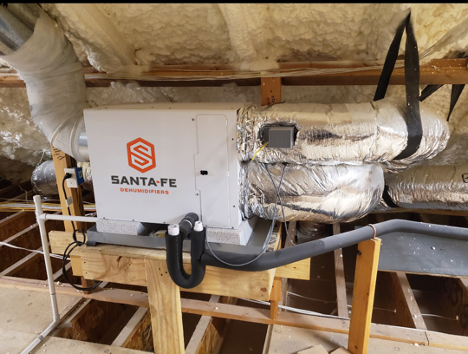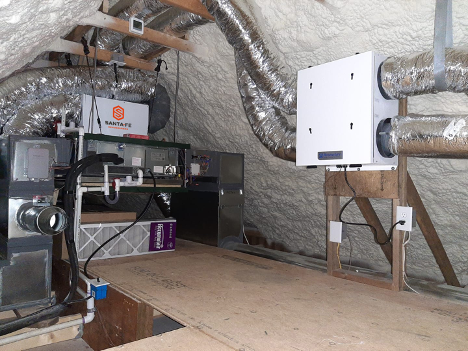Many homes, especially in mixed humid and hot humid climates, are experiencing interior moisture buildup resulting in uncomfortable living conditions and, more importantly, indoor air quality issues.
Why is Indoor Air Quality Important?
Indoor air quality has been ranked among the top five environmental risks to public health by the Environmental Protection Agency. Even more alarming is that according to Underwriters Lab, six out of ten homes are hazardous to the occupant’s health.
There are four critical components to achieving good indoor air quality: building a home with a tight envelope, mechanical ventilation, high efficiency filtration, and dedicated humidity control.
Build Tight
Controlling the air that leaks in and out of the home as much as possible is considered the first step when the goal is to improve the home’s comfort and indoor air quality. Unless we know where the air is coming from and what it is bringing with it, we have little chance in controlling the quality of the air. Once we get it tight, mechanical ventilation and moisture control methods need to be designed to match the upgraded building envelope, or the result could lead to an unhealthy living environment.
Ventilate Right
Bringing filtered outdoor air into a tightly sealed home from a known location to dilute indoor air contaminants is necessary. In a mixed humid and hot humid climate, you will also need to think about how to remove the humidity you are bringing into the home from the outside.
Keep Dry
Industry experts agree that changing building techniques and materials have resulted in the need to consider moisture control in homes across the country. According to Building Science Corporation, an international leading expert firm on high-performance home building techniques, most air conditioning equipment will not have the capability of removing the moisture load without overcooling the space — a condition likely to result in other problems. Supplemental dehumidification with a Santa-Fe Ultra whole house ventilating dehumidifier can complement the capability of the air conditioning (AC) system to remove moisture from the air within the conditioned space.

Supplemental dehumidification will almost certainly be necessary to maintain 50 percent relative humidity (RH) in a house in green grass climates (areas where dew points reach above 60 degrees F). Fifty percent RH is the condition used in ACCA’s Manual J and also the recommended level for minimizing volatile organic compound (VOCs) off-gassing, bacteria, viruses, dust mites, and microbial growth. What is important to note is that Manual J uses peak load outdoor conditions for the calculations. Most AC systems in the country will only run at peak load conditions one percent of the year. So how do you control the RH in the home to the recommended 50 percent the rest of the time?
Traditional practice left it up to the A/C system to remove this moisture in an attempt to keep it at an acceptable level. However, tightening houses limits the air conditioner run time, even when right-sized. It is important to remember that an A/C system only removes moisture when it is running. Shoulder seasons tend to be when dew points are highest, and temperatures are mild, resulting in high interior humidity levels with little to no moisture removal.
What about AC systems that claim better humidity control, like VRF, VRV, and ductless mini-split units?
The reality is most VRF / VRV / Ductless systems are programmed to prioritize efficiency over humidity removal. This is accomplished by decreasing the compression ratio as the indoor temperature approaches setpoint. The result is a warmer evaporator and less humidity removal as the equipment stages down. While many may expect the “variable” part of these systems to increase dehumidification, it is most common that the opposite occurs.
Every King Needs a Queen
Ken Gehring, AKA Teddy Bear on the forum HVAC-Talk and the inventor of Santa-Fe whole house ventilating dehumidifiers, wrote a post addressing just this, “The A/C is king and rules during high sensible cooling loads. Even with five-speed A/Cs, as the sensible cooling load declines, the amount of moisture removed is less than the infiltrating/ventilating high outdoor dew point plus moisture from occupants. The A/C is the king, single or multi-speed, but the…” queen, the whole-house dehumidifier, works with the king “…to remove the moisture…”
Santa-Fe whole-house ventilating dehumidifiers are designed to work with the home’s HVAC system to bring in outdoor air, filter the outdoor ventilation air, plus the air in the home (look for units that offer MERV 13 filtration), and dehumidify the air in the entire home to maintain a set RH level.

The Need for Whole-House Dehumidification
- Tighter energy-efficient homes: These homes actually trap moisture, odors, and VOCs, creating an unhealthy, uncomfortable environment.
- Homeowners today are more aware and educated on the effects of indoor air quality and how it relates to their health.
- Rise in respiratory ailments: Asthma and allergies have increased dramatically in the last several years.
- People spend more time in their homes: Hence they breathe more, cook more, add more plants, pets, etc., all of which contribute to creating more moisture in a tighter home.
As homes become tighter and more energy-efficient, our strategies for ensuring good indoor quality need to evolve. In the past, if a home needed a dehumidifier, fingers pointed, and someone did something wrong. Today’s homes need less heating and cooling, yet moisture needs to be controlled to ensure a healthy, comfortable, and safe home.

